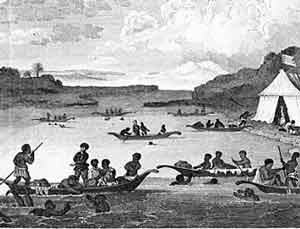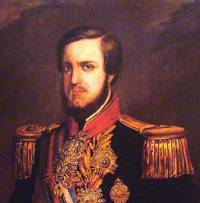
History of Brazil: The Tapuia people, ca. 1650 (by Albert Eckhout)
Tupi war with Tapuia
In the late 1400s AD, the Tupi people had just won a big war with the Tapuia people. They had gotten control of the Atlantic coast of South America (modern Brazil). They forced most of the Tapuia people inland. So the Tupi were living near the beaches, fishing and farming.
The Tupi and Brazil before colonization
South American history
All our South America articles
How did the Tupi live?
Different Tupi groups had different rulers, but they all lived more or less the same way and spoke the same language. There were probably about a million of them.
What did Tupi people eat?
They were mostly fishermen or farmers growing a variety of South American plants: corn, yuca root, sweet potatoes, beans, peanuts, tobacco, squash, and cotton.
History of fishing
Where did corn come from?
How about tobacco?

Enslaved Africans pearl diving in Brazil.
When did Europeans reach Brazil?
In April, 1500 AD, the first trading ship unexpectedly arrived from Portugal, with Pedro Álvares Cabral.
Medieval ships and sailing
Medieval Spain
Europeans enslave Brazilians
The Tupi people could not defend themselves against European weapons. So the Europeans (many of them Jesuit priests) enslaved many Native men and women and forced them to work. The Europeans forced the Tupi to mine silver and dive for pearls.
History of silver
History of slavery
Who were the Jesuits?
What was smallpox?
Or they had to grow sugar cane, cattle, and tobacco to export to Europe. Most of the Tupi soon caught European diseases – smallpox and measles and malaria and dysentery – and died. Others died of starvation and overwork. There were many accidents in the dangerous mines.

History of Brazil: Ocean currents went right from West Africa to Brazil, making it easy to import African people.
Europeans bring Africans to Brazil
In the early 1500s, Spain became part of the Holy Roman Empire, and so did Brazil. The Europeans began to bring over thousands of Africans who were enslaved to work in Brazil. Most of the Africans who were enslaved were sold in Brazil – millions of them.
African-American slavery
The Holy Roman Empire was under Charles V. Charles V ruled not only Portugal but most of Europe: Spain, the Netherlands, Germany, Austria, Hungary, and most of Italy.
Who was Charles V?
How did he get control of Spain?
Yellow fever kills many Brazilians
All together, more than four million people came to Brazil as slaves. Most of them died of overwork in a few years. They brought yellow fever with them.
What is yellow fever?
Sugar and slavery
Where do pearls come from?
So many native Tupi and Tapuia people died of yellow fever in 1685. Meanwhile many Europeans got rich selling Brazilian sugar, silver, and pearls. Portuguese soldiers fought French soldiers to extend Brazil further north and south along the Atlantic coast.

Jesuit teachers in Brazil
Brazil fights Angola to keep enslaving Africans
In the late 1600s AD, with Queen Mariana ruling Spain, Portugal seized its independence. So Brazil became part of the Kingdom of Portugal rather than Spain.
More about Queen Mariana
And Queen Jinga Mbandi
But the Portuguese colonizers still relied on African slavery. When Angola’s Queen Jinga Mbandi in Africa refused to sell any more enslaved people to Brazil’s settlers, the settlers sent an army to Angola. That was in 1661. The Brazilian settlers defeated Jinga Mbandi and the Angolans so they could get more slaves.
Gold mines and coffee
Brazil couldn’t sell as much sugar or silver by the late 1600s, but then explorers found gold mines, and Brazil got rich again selling gold. Many people came from Portugal to Brazil to get gold. Jesuits owned more and more of the wealth in Brazil: farms, mines, ranches, everything. They started to grow coffee in Brazil too.
Isn’t coffee from Africa?
History of gold
More about the Jesuits

History of Brazil: Emperor Pedro II of Brazil (1851)
Brazil becomes an independent country
In the 1750s, Portugal’s kings threw out the Jesuits and took over the huge plantations and ranches that the Jesuits controlled. Then in 1808 the King of Portugal moved to Brazil for years, running away from Napoleon.
Who was Napoleon?
Walpole and Pitt in Britain
The British defeated Napoleon in 1815, and the King of Portugal moved back to Portugal in 1821. He left his son, Pedro, in charge in Brazil. Prince Pedro then fought a war against his father for independence and became Emperor Pedro of Brazil. So Brazil was an independent country, but still ruled by European settlers.
German immigration to Brazil
To build up the population, Emperor Pedro encouraged people to move to Brazil from Germany, and many did, especially after the European revolutions of 1848. But a lot of Brazilians hated Emperor Pedro. He quit in 1831, leaving regents to rule in the name of his 5 year old son, Pedro II. When Pedro II grew up, he built clean water systems, sewage systems, and railroads.
Germany and 1848
Austria-Hungary in the 1800s
Cholera and clean water

A white man beating an enslaved African man in Brazil
When did Brazil finally end slavery?
But even after independence, and even after the United States’ Civil War freed African-Americans in the United States, Brazil’s government still insisted that slavery was the way to go. Many American slave-holders moved to Brazil after they lost the war, so they could keep on owning and abusing people.
United States Civil War
What is sharecropping?
Slavery didn’t officially end in Brazil until more than twenty years later, in 1888, and even after that (as in the United States) many people of color still worked under terrible conditions, as sharecroppers or laborers.

Brazilians peeling yuca (1930s)
Italian immigration to Brazil
But because Brazil couldn’t force any more Africans to come to Brazil, they encouraged lots of free people to come from Italy (where Pedro II’s wife came from) to work on the coffee plantations.
The Republic of Brazil
A year after slavery ended, in 1889, the army threw Pedro II out and started the Republic of Brazil. By the early 1900s, people were coming to Brazil from Japan, Syria, and Lebanon, as well as from all over Europe. More recently, many people have been moving to Brazil from China. The history of Brazil is one of immigration from many different places, but there are still a lot of people in Brazil who are descended from Native Tupi and Tapuia people.
Did you find out what you wanted to know about the history of Brazil? Let us know in the comments!
Looking for more? Check out this article from the Encyclopedia Britannica.